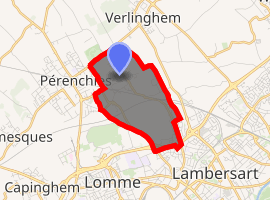Lompret
Lompret is a commune in the Nord department in northern France.
Lompret | |
|---|---|
The town hall in Lompret | |
_Nord-France.svg.png) Coat of arms | |
Location of Lompret 
| |
 Lompret  Lompret | |
| Coordinates: 50°40′10″N 2°59′24″E | |
| Country | France |
| Region | Hauts-de-France |
| Department | Nord |
| Arrondissement | Lille |
| Canton | Lambersart |
| Intercommunality | Métropole Européenne de Lille |
| Government | |
| • Mayor (2014-2020) | Hélène Moeneclaey |
| Area 1 | 3.1 km2 (1.2 sq mi) |
| Population (2017-01-01)[1] | 2,299 |
| • Density | 740/km2 (1,900/sq mi) |
| Time zone | UTC+01:00 (CET) |
| • Summer (DST) | UTC+02:00 (CEST) |
| INSEE/Postal code | 59356 /59840 |
| Elevation | 22–34 m (72–112 ft) (avg. 39 m or 128 ft) |
| 1 French Land Register data, which excludes lakes, ponds, glaciers > 1 km2 (0.386 sq mi or 247 acres) and river estuaries. | |
It is part of the Urban Community of Lille Métropole.
Heraldry
_Nord-France.svg.png) Arms of Lompret |
The arms of Lompret are blazoned : Or, 3 chevrons sable. (Bersillies, Boeschepe, Boussières-sur-Sambre, Colleret, Cousolre, Flaumont-Waudrechies, Hautmont, Limont-Fontaine, Lompret, Masny, Neuville-en-Avesnois and Saint-Rémy-du-Nord use the same arms.) |
gollark: They are not the most power-efficient machines, though.
gollark: Well, I have an old tower with 4GB of RAM and an E3-1240 v1 which cost £100.
gollark: You can get surprisingly good old enterprise servers off ebay cheaply.
gollark: Can you *not* start a server for some reason?
gollark: y̞̔ͥà͇̟yͨ͌̈ ̧̍̒f̥̥̉o̯͒ͦr̼͑̆ ͓̑̀u̷̦̝n͕̓́i͚̼̱҉c̻̯̪o̒ͤ̃d͖̣̾eͯͥ̾ ̩̩̕aͪ̇ͦñ̞̄d̈̍ͅ ͌ͭ̌m͖ͩ͞y̪̲̾ ͪͩ̂t̜͋̎ë̸̀x̯̼̘t̙̞̐ ̘̳̅f͙̘͜ì͈͛d̀̾͘d͍ͤͨl̙͉̘i̵̬ͅn̬̓̏gͣ҉̲͑̃ ̩͕ͧt͙ͤͅo͒͌ͩoͨ̎̑ĺ̺̉ĉ̥̐h́̈́̂a͙͎͋i̭͖̚n̄̿̒!̶̟̗
See also
References
- "Populations légales 2017". INSEE. Retrieved 6 January 2020.
| Wikimedia Commons has media related to Lompret (Nord). |
This article is issued from Wikipedia. The text is licensed under Creative Commons - Attribution - Sharealike. Additional terms may apply for the media files.
.svg.png)